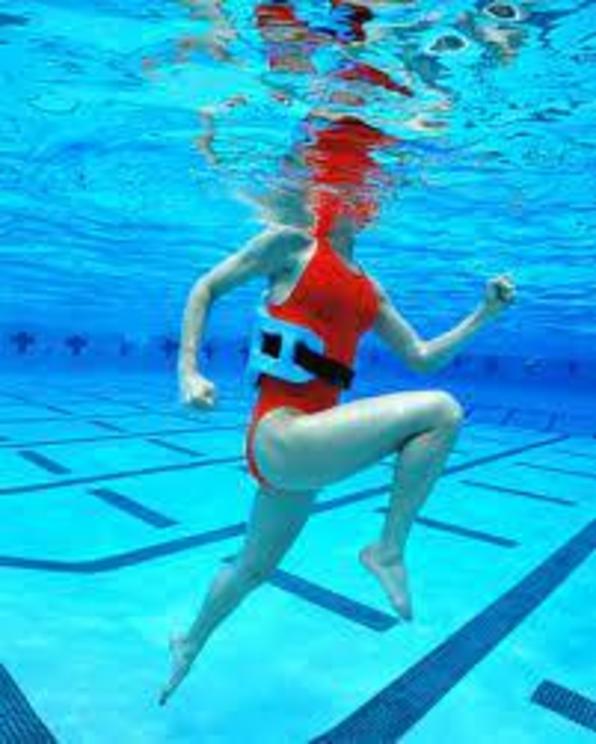Why aqua jogging is a great workout
Medically reviewed by Erin Pereira, PT, DPT
Running is one of the most popular activities in the United States.1 But it’s also a high-impact activity that can lead to common lower-body injuries.2 This doesn't negate the good that comes from regularly heading out for a run, but adding some variety to your cardio may benefit you. One solution? Aqua jogging.
What is Aqua Jogging?
Aqua jogging is a unique crossbreed of running and swimming that can help you maintain cardiovascular endurance and running form while reducing the wear and tear from road running.
Also popularly known as deep water running, aqua jogging can be done year-round, either outdoors in the summer or indoors in the winter. You can do aqua jogging in a guided class or by running laps in the pool or running in place.
Who is aqua jogging best suited for? Just about everyone.
Older Adults
The activity can be particularly appealing to the baby boomer generation as a way to keep cardiovascular endurance up, but the impact on joints down. When performed twice a week, aqua jogging has been shown to increase explosive strength, body composition, and blood pressure.
Injured Runners
It’s also a great option for runners–particularly those who are injured and want a low-impact activity. Swimming-based exercises have been shown to help with the regeneration of new muscle fibers caused by injury.3 Aqua jogging allows you to stay active while you heal.
Pregnant Women
Water aerobics, including aqua jogging, is also a safe, low-impact option for pregnant women. One study found that women who performed water aerobics were less likely to request pain killers during labor.4
Professional Runners
Many professional runners add aqua jogging to their regiment when injured, or to supplement their intense training programs. When some elite athletes continued to train in water, they experienced little to zero loss of aerobic capacity for up to eight weeks.5
A combination of aqua jogging and land running is a good kicking-off point for beginner runners, who might be nervous to hit the streets right away but want to get familiar with the motion, action, and length of running.
Health Benefits
Aside from causing less friction on your joints, aqua jogging can help increase your cardiovascular strength, improve posture and form, and increase muscular strength.
Low Impact Exercise
Water exercises remove the impact of hitting hard surfaces, like asphalt or concrete. The reduced stress on joints can help reduce the risk of injury to the body.6
Builds Strength
Water is dense and adds resistance to this activity. According to the Arthritis Foundation, water provides 12 times the resistance of air, which can help build, strengthen, and tone muscles. Because water is denser and harder to maneuver through, you work harder and essentially burn more calories while increasing muscular strength.
Your Pace Doesn't Matter
Being hyper-focused on the demands of a training routine, including your pace, length, or outcome of performance can increase the risk of poor mental health.7 But in water, everyone is working against and with the same amount of exertion, so there’s no pressure to try to speed up and go faster.
May Assist in Weight Management
Like regular running, aqua jogging provides aerobic activity and resistance training while burning calories and fat to help maintain weight or aid in weight loss.
The Equipment You'll Need
You might feel out-of-place strapping on a pair of swimming goggles versus tying up running shoes, but as with most sports, aqua jogging comes with its unique set of exercise accessories, designed to aid in your success.
There are many types of equipment to help aid or elevate your aqua jogging practice in the pool.
For beginners, you can first focus on the basics, including an athletic swimsuit, swimming goggles, and often a swim cap.
Belts come into place once you become familiarized with the activity. They can be clipped around the waist to add buoyancy while in the water, which allows you to focus on posture and movement while keeping your head afloat.
For experienced aqua joggers, you can also use water weights for added resistance.
Sample Workout
If you’re ready to try swapping the road for the pool, here are a few movements to get you started.
Warm-Up
Perform 5-10 minutes of running or walking movements in the water. This will get your muscles warm and help you adjust to a new center of balance in the water.
Intervals
Repeat the following 2-4 times based on your skill level and duration of your training regimen. You can increase the intensity by adding water weights to any movement.
- 1-minute of a cadence run (starting at a slow cadence and gradually increasing over the course of the minute)
- 8 sets of 5-second sprints, with 15 seconds of recovery in between each sprint
- 1-minute of water walking
- 1-minute of a cadence run
- 5 sets of 30-second hard cross country running (a hard effort of the legs, traveling forward and backward in the water), with 30 seconds of recovery in between each set
- 1-minute of a cadence run
- 6-8 sets of 10-second high knees, with 15 seconds of recovery jogging in between each set
- 1-minute of a cadence run
- 1-minute of water walking
- 1-minute of a cadence run
Cool-Down
Perform 5-10 minutes of light running or walking movements in the water, similar to the movements conducted in your warm-up.
A Word From Verywell
Aqua jogging is an excellent way to incorporate a new, low-impact form of cardio into your workout routine. If you have concerns about adding this activity to your fitness routine, speak to a health care professional.

